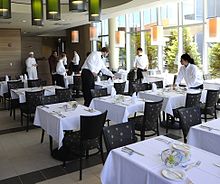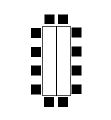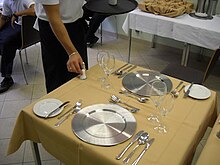Cover

The Coverslipping a guest table is part of the food culture and is one both for labels and for the training of restaurant and hotel professionals.
Covering takes place according to a predetermined sequence. A table setting (also known as a French envelope ) is prepared for each guest , which is set and set depending on the occasion and menu .
Work
The following work steps count for covering:
"Woodwork": aligning the tables and chairs
This term describes the cleaning and alignment of tables and chairs. They are distributed around the room as required. This process depends on the number of people, the size of the room and the occasion of the event. When setting up the tables, it should be noted that every guest should sit with a view of a window front or an attractive point in the room if possible. Make sure that there is enough space between the rows of tables so that the guest is not bothered in any way. All tables must be precisely aligned. If it is necessary, a cork disc is placed under the table leg so that the table no longer wobbles. The space available per guest should not be less than 70 centimeters, ideally you give the guest 80 centimeters. After setting up, the chairs are turned off so that they can work better at the table.
- Various banquet seating
Laying on the table linen
Thereafter, that is linen launched, starting with the table supports from Molton (if it is not already fixedly mounted on the table top), followed by tablecloths , runner , center pieces and / or placemats . The molton, which is placed directly on the table, protects the table top and the tablecloth. It also muffles the noises when setting down the dishes and glasses. To place the tablecloth, hold the middle section of the folded blanket between your thumb and index fingers and the upper edge between your index and middle fingers. The tablecloth is swung over the opposite edge of the table and then the middle break held between the thumb and forefinger is released. At the end, the tablecloth is pulled over the table with the index and middle fingers. The tablecloths are placed in such a way that the central break is, if possible, parallel to the long side of the room and the upper break faces the window. Do not run your bare hand over the tablecloth. Large tablecloths should therefore always be placed by at least two people, which also prevents the tablecloth from creasing. Alternatively, instead of molton and tablecloth, just one placemat can be set. With particularly beautiful tables, even for very formal banquets, no table top can be used, such as state banquets at Windsor Castle .
decoration
Before starting the actual setting, the table decorations should be attached. There are no restrictions here. Flower arrangements, fruit bowls and knickknacks are popular. For the normal meals of the day, breakfast, lunch and dinner, the tables are provided with beautiful but simple decorations. The following basic rules should be observed when decorating banquet tables:
The decoration must match the occasion and at the same time not make the serving process unnecessarily difficult (the table should not be overloaded with decoration). The height of the decoration must not obstruct the view over the board to other people (especially lights, e.g. burning candles). If the table is so deep that the guests cannot talk over it, this rule does not have to be strictly adhered to. When arranging the decoration, it is advisable to start from the center of the board and then orient it towards the sides.
Cover the envelope
Internationally, regionally and according to the different occasions, there are different rules for which, how many, how and where drinking vessels, crockery and cutlery etc. are set.
Cruets
As pails on a guest table refers to vessels belonging to cutlery and a matching rack or serving plate for salt and other spices, sugar and milk or cream, which are placed on the table. Usually there is a cruet set for several guests, rarely one for each guest.
Mouth napkins
The napkins breaking is the technical term for the elaborate folds of the face servicing .
Folding
Folding or flattening describes the smooth stripes of the tablecloth at the edges.
Table arrangement and menu cards
Finally, in the case of meals with a fixed sequence of dishes and table arrangements, the menu cards, place cards and, if applicable, table numbers are placed on stands or placed on the tables. A final check completes the coverslipping.
literature
- F. Jürgen Herrmann: Gastronomy. Elementary level. Main band. 7th expanded edition. Verlag Handwerk und Technik, Hamburg 2011, ISBN 978-3-582-40050-5 .
- Harald Dettmer (ed.): Hospitality professions in theory and practice. Main band. 6th, revised edition. Verlag Handwerk und Technik, Hamburg 2008, ISBN 978-3-582-04963-6 .
Web links
- Cover - a service customer for the hotel industry
- Work steps - setting up a 4-course menu for 2 people
Individual evidence
- ↑ Kathryn Jones: Dining at the Palace. Guest of the Queen , 2009
- ↑ Service customer & guest care. Table linen. In: Europa-Lehrmittel . Accessed March 31, 2019 .
- ↑ a b c The envelope The perfectly laid table EXAM PREPARATION FOR HOSPITALITY PROFESSIONS. Europe teaching materials , accessed March 31, 2019 .
- ↑ Broken serviettes ( Memento of the original from March 4, 2016 in the Internet Archive ) Info: The archive link was inserted automatically and has not yet been checked. Please check the original and archive link according to the instructions and then remove this notice.
- ↑ Service customer & guest care. Table linen. In: Europa-Lehrmittel . Accessed March 31, 2019 .







